Pavlova Recipe
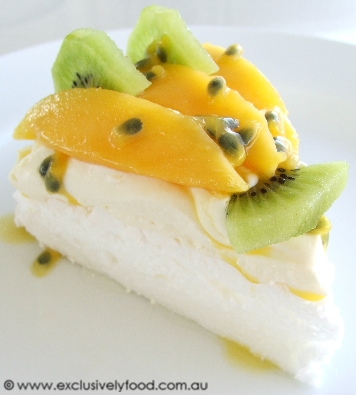
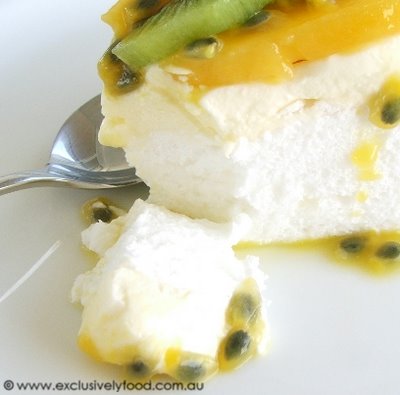 This melt-in-the-mouth pavlova has a soft, marshmallowy centre and a thin, crisp and fragile outer shell. Serve it topped with a generous amount of whipped cream and fruit. We like to use passionfruit and soft fruits such as berries, mango, kiwifruit and cherries.
This melt-in-the-mouth pavlova has a soft, marshmallowy centre and a thin, crisp and fragile outer shell. Serve it topped with a generous amount of whipped cream and fruit. We like to use passionfruit and soft fruits such as berries, mango, kiwifruit and cherries.
Start this recipe at least 3 1/2 hours, and up to one day, before serving time. Measure out the cream of tartar and caster sugar before you start beating the egg whites so you don't have to stop beating to do this. For more information on separating eggs, see the tips at the bottom of the recipe.
There is no substitute for cream of tartar in this recipe.
Serves 8.
We use a 20ml tablespoon and 250ml measuring cup for all of our recipes.
4 large egg whites, at room temperature (we use eggs with a minimum weight of 59g)
3/4 teaspoon (1/2 teaspoon plus 1/4 teaspoon) cream of tartar
200g (3/4 cup plus 2 tablespoons) caster sugar
Topping
About 400ml (1 2/3 cups) thickened cream, whipped
Fruit of your choice
Preheat oven to 200 degrees Celsius (180 degrees Celsius fan-forced).
Using a pencil, draw a 20cm diameter circle on a sheet of non-stick baking paper. We trace around the inside of a 20cm diameter springform pan (base removed).
Place paper, pencil side down (so the pencil doesn't touch the pavlova), on a large baking tray. If your baking tray is a dark colour and you find it difficult to see the pencil line, you can place the baking paper on a light-coloured surface to make the line easier to see. Once you've spread the pavlova onto the paper, transfer it to the baking tray.
To make the pavlova, you'll need electric hand-held beaters and a large bowl, or an electric mixer with a large bowl. Ensure that the beaters and bowl are very clean as oils can prevent egg whites from whipping properly.
As soon as you begin to beat the egg whites, add the cream of tartar. Beat the egg whites on high speed just until they reach the following stage: when the beaters are lifted out of the egg white mixture, the mixture forms and holds a peak that doesn't flop over at the tip. It will probably take 1-2 minutes for your egg white mixture to reach this stage. © exclusivelyfood.com.au
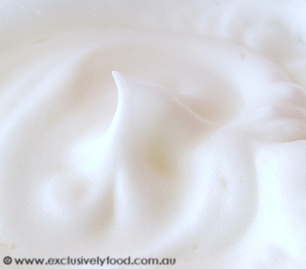
Sprinkle one tablespoon of the sugar over the egg white mixture. Continue beating, and add one tablespoon of sugar about every 30 seconds.

Once all of the sugar has been added, continue to beat the mixture for 2 minutes. The mixture should be very thick and glossy.
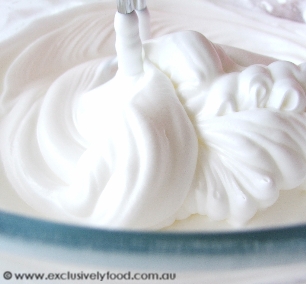
Pile the mixture inside the circle on the baking paper. Smooth the mixture out to form a cake shape, keeping to the pencil line.
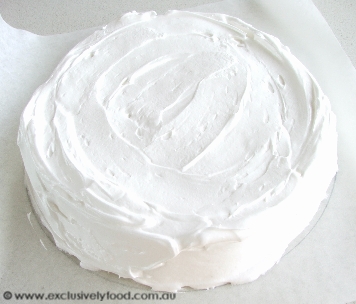
Place the pavlova in the middle of the preheated oven, and then immediately reduce the heat to 100 degrees Celsius (80 degrees Celsius fan-forced). Bake for 1 hour. The pavlova will probably crack and sink during baking.
When the pavlova has finished baking, turn the oven off but leave the pavlova in the oven. Prop the oven door open a couple of centimetres (we use a folded tea towel). Leave the pavlova to cool in the oven for 2 hours.
Remove the pavlova from the oven and allow it to cool to room temperature. Then transfer it to an airtight container until required. When ready to serve, slide pavlova off baking paper onto a serving plate, top with whipped cream and fruit and serve immediately.
Separating eggs:
It is easier to separate eggs when they are cold. We separate eggs straight from the refrigerator then leave the whites to come to room temperature.
Ensure that no egg yolk gets into the egg white. If some egg yolk does get into the white, don't attempt to scoop it out: use the egg for another purpose. The presence of even a tiny amount of yolk can prevent the egg whites from whipping properly.
We crack an egg over a small bowl to collect the white, and then transfer the white into the mixing bowl before repeating with the next egg. This way, if you accidentally break a yolk, or if one of the eggs is bad, you won't spoil more than one egg white.
If you don't have an egg separator, you can use your hand. Use your fingers to catch the yolk while the white passes between your fingers into the bowl below. © www.exclusivelyfood.com.au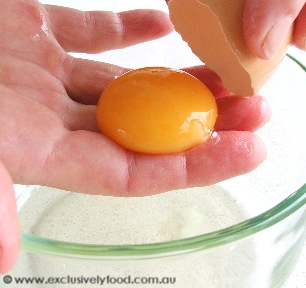
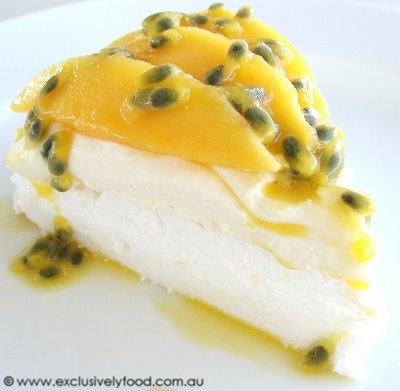
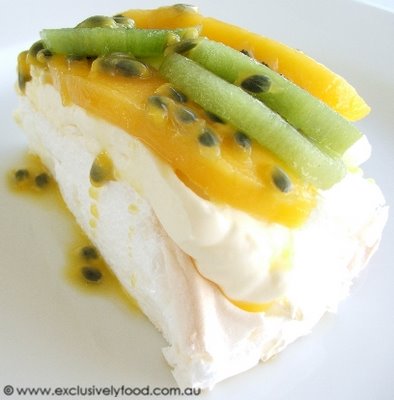
Haloumi and Avocado Salad Recipe
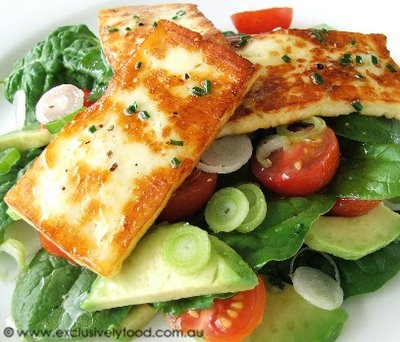 Slices of salty, squeaky haloumi cheese are pan fried until golden brown and served on a bed of avocado, tomato, green onion and baby spinach. The amount of haloumi cheese can be increased to make a more substantial meal.
Slices of salty, squeaky haloumi cheese are pan fried until golden brown and served on a bed of avocado, tomato, green onion and baby spinach. The amount of haloumi cheese can be increased to make a more substantial meal.
Serves 3 as a light meal.
We use a 20ml tablespoon and 250ml measuring cup for all of our recipes.
75g baby spinach leaves
1 large avocado, peeled and sliced
180g cherry tomatoes, halved
24g (1/4 cup) finely chopped green onions (green shallots)
1 tablespoon (20ml) oil
180g haloumi cheese
Dressing
2 tablespoons (40ml) oil
2 tablespoons (40ml) lemon juice
Ground black pepper, to taste
1 teaspoon finely chopped garlic chives (or similar)
Divide the spinach, avocado, tomato and green onion between three serving plates. © exclusivelyfood.com.au
Place the dressing ingredients in a small screw-top jar.
Cut the haloumi cheese into nine 3/4cm slices. Heat one tablespoon of oil in a large frying pan over high heat. Add haloumi slices and fry until golden brown on both sides, turning once. The haloumi should take about two minutes to cook.
Place three slices of haloumi on top of each salad. Shake jar to combine dressing ingredients, and drizzle dressing over the salads. Serve immediately. © www.exclusivelyfood.com.au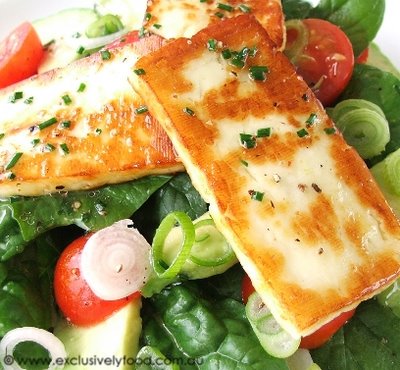
Beef Lasagne Recipe

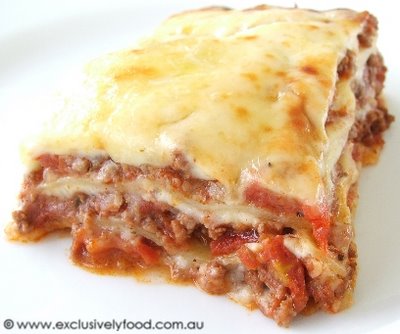 This lasagne consists of layers of rich meat sauce, creamy cheese sauce and tender pasta topped with a layer of golden melted cheese. We think it tastes even better reheated the next day.
This lasagne consists of layers of rich meat sauce, creamy cheese sauce and tender pasta topped with a layer of golden melted cheese. We think it tastes even better reheated the next day.
The cheese sauce can be prepared while the meat sauce is simmering.
Preparation time: about 1 hour and 15 minutes
Serves about 8-10.
We use a 20ml tablespoon and 250ml measuring cup for all of our recipes.
Meat Sauce
1 tablespoon (20ml) oil
1 large (about 200g) onion, peeled and finely chopped
100g shortcut bacon, finely chopped
750g lean beef mince
2 medium garlic cloves, peeled and crushed
100g (4 tablespoons) tomato paste
800g canned diced or crushed tomatoes
125ml (1/2 cup) red wine
1 teaspoon dried oregano leaves
1/2 teaspoon dried basil leaves
1 bay leaf
Salt and pepper, to taste
Cheese Sauce
90g butter
75g (1/2 cup) plain flour
800ml (3 cups + 2 1/2 tablespoons) milk
1/2 teaspoon ground nutmeg
65g (2/3 cup, firmly packed) grated parmesan cheese
Salt and pepper, to taste
Pasta
250g packet dry instant lasagne sheets (you probably won't need the full packet: the amount needed will depend on the measurements of your baking dish)
Cheese Topping
60g (1/2 cup, very firmly packed) grated mozzarella cheese
60g (1/2 cup, very firmly packed) grated tasty cheddar cheese
Meat Sauce
Heat oil in a very large saucepan over medium-high heat. Add onion and bacon and cook, stirring occasionally, for about 5 minutes, or until onion has softened.
Increase heat to high and add mince and garlic to the pan. Break up mince by mashing with a fork until no large clumps remain. Continue cooking, stirring occasionally, until all of the mince has changed colour.
Add tomato paste, diced tomatoes, red wine, oregano, basil and bay leaf to mince mixture and stir until combined.
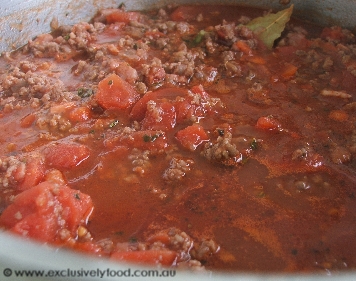
Once the mixture boils, reduce heat to about medium-low so that the mixture is simmering. Simmer, uncovered, for about 40 minutes, stirring occasionally. The meat sauce should be moist but not watery.

Discard the bay leaf. Season meat sauce with salt and pepper.
Cheese Sauce
Melt butter in a large saucepan over medium-low heat. Stir flour into melted butter and cook for 2-3 minutes, stirring constantly, until mixture bubbles. © exclusivelyfood.com.au
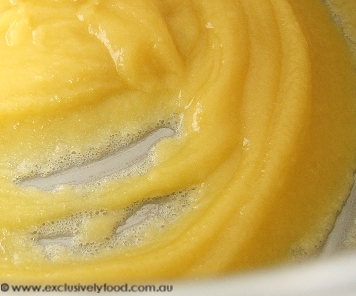
Remove saucepan from the heat. Add milk very gradually, stirring or whisking constantly.
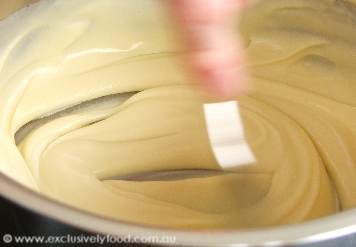
When all of the milk has been added and the sauce is smooth, return the saucepan to medium-high heat. Cook, stirring constantly, for about 7 minutes, or until sauce thickens. Remove from heat.
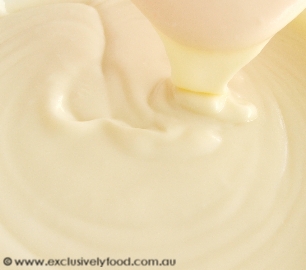
Add nutmeg and parmesan cheese to sauce and stir until well combined. Season to taste with salt and pepper.
Assembly
Preheat oven to 180 degrees Celsius (we have the fan switched off).
You will need a 3.25 litre (13 cup) capacity rectangular ovenproof dish. Use a dish that is about 6.5cm deep.
Spread about 1/2 cup of the cheese sauce over the base of dish. This thin layer of sauce will help prevent the pasta from sticking to the base of the dish. Completely cover the sauce with a single layer of lasagne sheets, cutting or breaking the sheets to fit the shape of the dish.
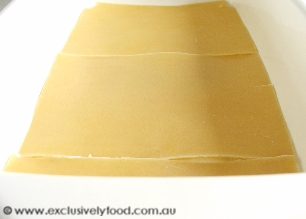
Spread one third of the meat sauce over the lasagne sheets.

Cover meat sauce with one third of the remaining cheese sauce. Top with another layer of lasagne sheets. Spread half the remaining meat sauce over the pasta. Spread half the remaining cheese sauce over the meat sauce. Cover cheese sauce with a layer of pasta. Spread with remaining meat sauce then remaining cheese sauce. Sprinkle with combined mozzarella and tasty cheese.
Cover lasagne with foil and bake for 30 minutes. Remove foil and bake for a further 15 to 30 minutes, or until cheese is golden and pasta is tender. Remove lasagne from the oven and set aside for 10 minutes to allow the lasagne to firm up slightly before cutting and serving.
Store lasagne in the refrigerator or freezer. © www.exclusivelyfood.com.au


.png)

